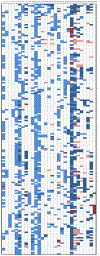A Systematic Literature Review of Whole Exome and Genome Sequencing Population Studies of Genetic Susceptibility to Cancer
- PMID: 32467344
- PMCID: PMC8279039
- DOI: 10.1158/1055-9965.EPI-19-1551
A Systematic Literature Review of Whole Exome and Genome Sequencing Population Studies of Genetic Susceptibility to Cancer
Abstract
The application of next-generation sequencing (NGS) technologies in cancer research has accelerated the discovery of somatic mutations; however, progress in the identification of germline variation associated with cancer risk is less clear. We conducted a systematic literature review of cancer genetic susceptibility studies that used NGS technologies at an exome/genome-wide scale to obtain a fuller understanding of the research landscape to date and to inform future studies. The variability across studies on methodologies and reporting was considerable. Most studies sequenced few high-risk (mainly European) families, used a candidate analysis approach, and identified potential cancer-related germline variants or genes in a small fraction of the sequenced cancer cases. This review highlights the importance of establishing consensus on standards for the application and reporting of variants filtering strategies. It also describes the progress in the identification of cancer-related germline variation to date. These findings point to the untapped potential in conducting studies with appropriately sized and racially diverse families and populations, combining results across studies and expanding beyond a candidate analysis approach to advance the discovery of genetic variation that accounts for the unexplained cancer heritability.
©2020 American Association for Cancer Research.
Conflict of interest statement
Figures

References
-
- Meztker ML. Sequencing technologies—the next generation. Nat Rev Genet 2010; 11:31–46. - PubMed
-
- Levy SE, Myers RM. Advancements in next-generation sequencing. Annu Rev Genom Hum Genet 2016; 17:95–115. Doi: 10/1146/annurev-genom-083115-022413. - PubMed
Publication types
MeSH terms
Grants and funding
LinkOut - more resources
Full Text Sources

